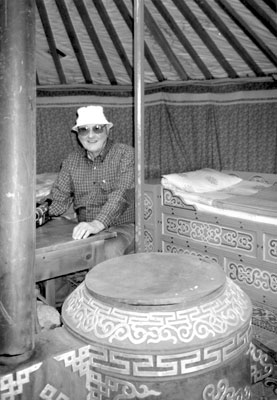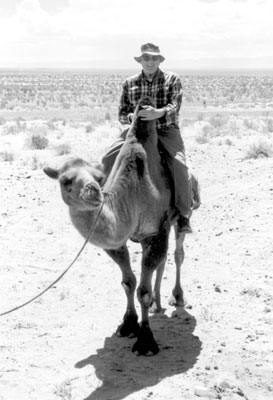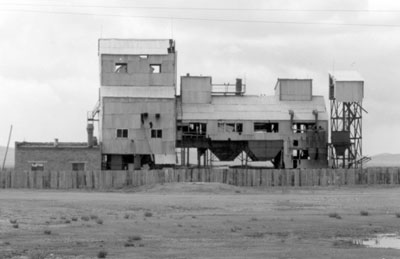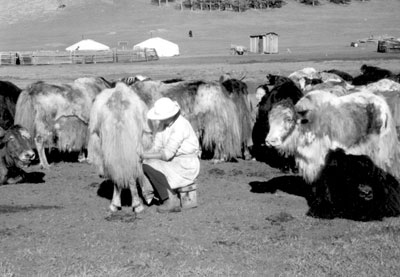Mongolia plus the Gobi
A customized, private tour to Mongolia was created for my wife, Darlene, and me for Aug 1-17, ’05. Featuring nomadic culture and Buddhist heritage, with an extension to the South Gobi desert, it was arranged by Original World/Spirit of India (Box 446, Mill Valley, CA 94942; 888/367-6147 or www.originalworldjourneys.com) and used Active/Adventure Tours of Ulaanbaatar, Mongolia.
The land cost of this trip was $2,968 per person ($2,188 plus $780 for the Gobi extension). Airfare was $2,298 ($1,608 Dallas/Fort Worth to Moscow and $690 on to Ulaanbaatar). The total per person was $5,266 ($292 per day). All accommodations, transfers, transport, meals and fees were included. No visa was required for U.S. citizens.
Only four nights were spent in the Bayangol Hotel in downtown Ulaanbaatar. There were no hotel accommodations outside of the towns, so 12 nights were spent in circular, felt-covered structures called gers. These were located in “ger camps,” each with its own restaurant, showers and Western-style toilets. The shower/toilet facilities usually were located quite a distance away from the gers.
Unfortunately, we didn’t always have warm showers or warm water for washing. They heated the water with a large outdoor stove, using wood, and this was done only once a day, in the late afternoon. Another inconvenience was the lack of electricity in most of the camps; they ran a generator for only three to four hours each evening.
Normally, our ger had two or three single beds, a table and chair and a small potbellied stove for heating (which we used only in the northern part). Some beds were quite comfortable, while others were terrible.
Meals varied quite a bit, but one thing that was common was that much of it was served “cold,” sometimes even fried eggs. In some areas we had fresh salad consisting of shredded carrots, cucumbers, tomatoes, etc. A kind of “potato salad” often was served. Also, we had fresh fruit, especially melon; otherwise, it was canned.
There are very few paved roads in Mongolia; they’re mainly in the north--central area. In the Gobi and in most of the central area west of Ulaanbaatar where we visited, the “roads” are trails that cut across country. There are no road signs, thus the driver or the guide must know the way. In some cases our driver had to ask for directions.
Often, many of the trails were very rough, so the long trips were very exhausting. In some areas we had to climb hills or stairs to reach the sight that we wanted to visit. It was rigorous touring.
We saw very few other tourists, normally meeting them at some of the ger camps where we were staying for the night.
We flew to the Gobi, along with our Mongolian woman guide, where we had a driver with a Russian jeep. We visited well-known tourist spots, including Yolyn Am (Eagle Valley) and the Khongoryn Els sand dunes (the Singing Sands), which are up to 300 meters high, 15 kilometers wide and 180 kilometers long.
Here we were able to ride Bactrian camels. The two humps are composed of fat and wiggle a lot when you hang onto one of them.
We visited the young family living in a ger who rented out the camels. We also visited Bayanzag (the Red Cliffs, aka the Flaming Cliffs), where Professor Roy Chapman Andrews discovered the famous Mongolian dinosaur eggs in 1921. Later his group discovered large dinosaur fossils.
We saw the smaller sand dunes called the Moltsog Els. En route we encountered a very large area of edelweiss, which previously we had seen only in the Alps. We also saw some rare black-tailed gazelle.
Upon our return to Ulaanbaatar (U.B.), we visited several important Buddhist sites and the National Museum. Before we left for the countryside, we went to a wholesale supermarket to buy 1_-liter bottles of water for our trip. Other than drinks such as bottled water, beer or wine, everything else was provided.
One of the highlights in U.B. was attending a performance of the National Dance troup which featured dancers in native costumes. The most impressive singer was a man who did “throat singing,” a special kind of singing that requires much training and is quite rare. We heard it only a couple more times at restaurant shows.
An expensive and irritating thing was having to buy permits to use camcorders and cameras. It cost $25 to film the National Dance show (which was okay) and sometimes as much as $15 to film in some monasteries where it was allowed. Camera-use costs ranged from $2 to $5.
In central Mongolia we had the same woman guide and a driver with a Toyota 4WD Land Cruiser. After leaving U.B. we traveled to the Manzushir Monastery in Bogd Khan Mountain National Park. The next day we visited a small monastery at Uygunt near Bayangovi before traveling to see Turtle Rock and nearby Erdene Zuu (Hundred Treasurers) Monastery, once one of the largest. Another important site was the Amarbayasgalant Khiid Monastery, where we saw four visiting Tibetan monks. We saw several other temples and remains of monasteries.
The most enjoyable part of the trip was seeing the scenery. Due to the summer rains prior to our arrival, most of the country was green and very pretty. There were numerous hills and steppes that added to the beauty of the countryside, along with bright blue skies and billowy clouds. The weather was mild, even in the Gobi.
In many areas we saw large herds of animals — camels, goats and sheep in the Gobi, and sheep and goats in other areas. In the north and central areas were large herds of yaks and khainags (a cross between a cow and a yak) and at other times herds of horses or a few cows.
Scattered all over were traditional gers of the nomads. In the winter the herdspeople move into permanent winter camps. Mongolia receives a large amount of snow then and is very cold.
Of great interest was the milking of (horse) mares and of yaks and khainags. Fermented mare’s milk is known as airag, and we saw youngsters selling it along the roads.
There were very few villages, few paved roads, only a few areas with electricity, and lots of abandoned telephone lines — i. e., little infrastructure.
This country was the home of Genghis Khan who, with his Mongol hordes in the 13th century, occupied most of the civilized world. Later the Chinese took over and, finally, the Soviets occupied Mongolia until the breakup in 1991-1992. We saw abandoned Soviet factories in every town and village.
In the north we saw large areas where they had tried to grow grain. Most of these areas are now grown up in weeds. Only a few places are being cultivated by the Mongolians to grow wheat. Everything is “dry farming.”
The Soviets denounced all religion and systematically destroyed most of the numerous Buddhist temples and monasteries. There were 70,000 monks when the Soviets took over; many monks were killed, and most of the rest were taken to Siberia to gulags.
Mongolia remains largely nomadic except in the few large towns. Most everything is still imported from Russia, along with a bit from China and Korea.
This is a unique country to visit because it is just being discovered by travelers who want something different. It requires a lot of stamina.
WAYNE A. SCHILD
Austin, TX




